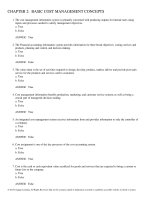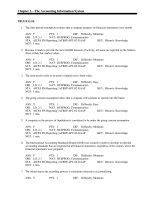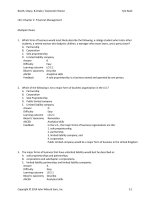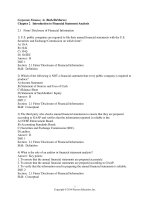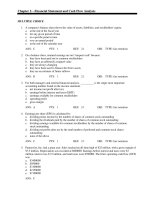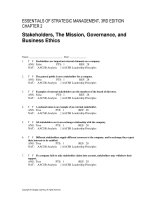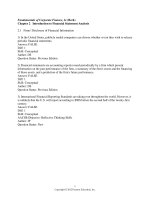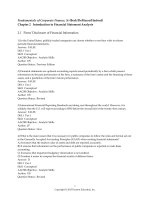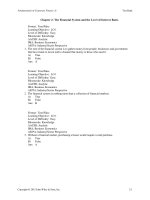Fundamentals of corporate finance 3rd edition berk test bank
Bạn đang xem bản rút gọn của tài liệu. Xem và tải ngay bản đầy đủ của tài liệu tại đây (833.6 KB, 58 trang )
Fundamentals of Corporate Finance, 3e (Berk/DeMarzo/Harford)
Chapter 2 Introduction to Financial Statement Analysis
2.1 Firms' Disclosure of Financial Information
1) In the United States, publicly traded companies can choose whether or not they wish to release
periodic financial statements.
Answer: FALSE
Diff: 1 Var: 1
Skill: Conceptual
AACSB Objective: Analytic Skills
Author: DS
Question Status: Previous Edition
2) Financial statements are optional accounting reports issued periodically by a firm which present
information on the past performance of the firm, a summary of the firm's assets and the financing of those
assets, and a prediction of the firm's future performance.
Answer: FALSE
Diff: 1 Var: 1
Skill: Conceptual
AACSB Objective: Analytic Skills
Author: DS
Question Status: Revised
3) International Financial Reporting Standards are taking root throughout the world. However, it is
unlikely that the U.S. will report according to IFRS before the second half of the twenty-first century.
Answer: FALSE
Diff: 1 Var: 1
Skill: Conceptual
AACSB Objective: Analytic Skills
Author: JP
Question Status: New
4) What is the main reason that it is necessary for public companies to follow the rules and format set out
in the Generally Accepted Accounting Principles (GAAP) when creating financial statements?
A) It ensures that the market value of assets and debt are reported accurately.
B) It ensures that information on the performance of public companies is reported on cash-basis
accounting.
C) It ensures that important budgetary information is not omitted.
D) It makes it easier to compare the financial results of different firms.
Answer: D
Diff: 1 Var: 1
Skill: Conceptual
AACSB Objective: Analytic Skills
Author: DS
Question Status: Revised
1
Copyright © 2015 Pearson Education, Inc.
5) Which of the following best describes why a firm produces financial statements?
A) to use as a tool when planning future investments within a firm
B) to increase the intrinsic value of a firm
C) to provide a means for interested outside parties such as creditors to obtain information about a firm,
with an overview of the short- and long-term financial condition of a business
D) to show the daily activities a firm has undertaken in the previous financial year, and what activities
are planned for the near future
Answer: C
Diff: 1 Var: 1
Skill: Conceptual
AACSB Objective: Analytic Skills
Author: DS
Question Status: Revised
6) The exchanges in which of the following countries or regions do NOT accept the International
Financial Reporting Standards set out by the International Accounting Standards Board?
A) Germany
B) France
C) United States
D) United Kingdom
Answer: C
Diff: 1 Var: 1
Skill: Conceptual
AACSB Objective: Analytic Skills
Author: DS
Question Status: Previous Edition
7) Which of the following is NOT one of the financial statements that must be produced by a public
company?
A) the balance sheet
B) the income statement
C) the statement of cash flows
D) the statement of activities
Answer: D
Diff: 1 Var: 1
Skill: Conceptual
AACSB Objective: Analytic Skills
Author: DS
Question Status: Previous Edition
2
Copyright © 2015 Pearson Education, Inc.
8) U.S. public companies are required to file their annual financial statements with the U.S. Securities and
Exchange Commission on which form?
A) 10-A
B) 10-K
C) 10-Q
D) 10-SEC
Answer: B
Diff: 1 Var: 1
Skill: Definition
AACSB Objective: Analytic Skills
Author: JN
Question Status: Previous Edition
9) Which of the following is NOT a financial statement that every public company is required to produce?
A) income statement
B) statement of sources and uses of cash
C) balance sheet
D) statement of stockholders' equity
Answer: B
Diff: 2 Var: 1
Skill: Conceptual
AACSB Objective: Analytic Skills
Author: JN
Question Status: Previous Edition
10) The third party who checks annual financial statements to ensure that they are prepared according to
Generally Accepted Accounting Principles (GAAP) and verifies that the information reported is reliable is
the ________.
A) NYSE Enforcement Board
B) Accounting Standards Board
C) Securities and Exchange Commission (SEC)
D) auditor
Answer: D
Diff: 1 Var: 1
Skill: Definition
AACSB Objective: Analytic Skills
Author: JN
Question Status: Revised
3
Copyright © 2015 Pearson Education, Inc.
11) What is the role of an auditor in financial statement analysis?
Answer: Key points:
1. to ensure that the annual financial statements are prepared accurately
2. to ensure that the annual financial statements are prepared according to Generally Accepted
Accounting Principles (GAAP)
3. to verify that the information used in preparing the annual financial statements is reliable
Diff: 2 Var: 1
Skill: Conceptual
AACSB Objective: Analytic Skills
Author: JN
Question Status: Previous Edition
12) What are the four financial statements that all public companies must produce?
Answer:
1. balance sheet
2. income statement
3. statement of cash flows
4. statement of stockholders' equity
Diff: 2 Var: 1
Skill: Conceptual
AACSB Objective: Analytic Skills
Author: JN
Question Status: Previous Edition
2.2 The Balance Sheet
1) The balance sheet shows the assets, liabilities, and stockholders' equity of a firm over a given length of
time.
Answer: FALSE
Diff: 2 Var: 1
Skill: Conceptual
AACSB Objective: Analytic Skills
Author: DS
Question Status: Previous Edition
2) Stockholders' equity is the difference between a firm's assets and liabilities, as shown on the balance
sheet.
Answer: TRUE
Diff: 1 Var: 1
Skill: Conceptual
AACSB Objective: Analytic Skills
Author: DS
Question Status: Previous Edition
4
Copyright © 2015 Pearson Education, Inc.
3) Which of the following amounts would be included on the right side of a balance sheet?
A) the value of government bonds held by the company
B) the cash held by the company
C) the amount of deferred tax liability held by the company
D) the amount of money owed to the company by customers who have not yet paid for goods and
services they have received
Answer: C
Diff: 2 Var: 1
Skill: Conceptual
AACSB Objective: Analytic Skills
Author: DS
Question Status: Revised
4) Which of the following best describes why the left and right sides of a balance sheet are equal?
A) In a properly run business, the value of liabilities will not exceed the assets held by the company.
B) By definition, the assets plus the liabilities will be the same as the stockholders' equity.
C) The assets must equal liabilities plus stockholders' equity because stockholders' equity is the difference
between the assets and the liabilities.
D) By accounting convention, the assets of a company must be equal to the liabilities of that company.
Answer: C
Diff: 1 Var: 1
Skill: Conceptual
AACSB Objective: Analytic Skills
Author: DS
Question Status: Revised
5) A company that produces drugs is preparing a balance sheet. Which of the following would be most
likely to be considered a long-term asset on this balance sheet?
A) commercial paper held by the company
B) the inventory of chemicals used to produce the drugs made by the company
C) a patent for a drug held by the company
D) the cash reserves of the company
Answer: C
Diff: 1 Var: 1
Skill: Conceptual
AACSB Objective: Analytic Skills
Author: DS
Question Status: Previous Edition
5
Copyright © 2015 Pearson Education, Inc.
6) A delivery company is creating a balance sheet. Which of the following would most likely be
considered a short-term liability on this balance sheet?
A) the depreciation over the last year in the value of the vehicles owned by the company
B) revenue received for the delivery of items that have not yet been delivered
C) a loan which must paid back in two years
D) prepaid rent on the offices occupied by the company
Answer: B
Diff: 1 Var: 1
Skill: Conceptual
AACSB Objective: Analytic Skills
Author: DS
Question Status: Revised
7) A small company has current assets of $112,000 and current liabilities of $117,000. Which of the
following statements about that company is most likely to be true?
A) Since net working capital is negative, the company will not have enough funds to meet its obligations.
B) Since net working capital is high, the company will likely have little difficulty meeting its obligations.
C) Since net working capital is very high, the company will have ample money to invest after it meets its
obligations.
D) Since net working capital is nearly zero, the company is well run and will have little difficulty
attracting investors.
Answer: A
Diff: 1 Var: 1
Skill: Conceptual
AACSB Objective: Analytic Skills
Author: DS
Question Status: Revised
8) What is the main problem in using a balance sheet to provide an accurate assessment of the value of a
company's equity?
A) Valuable assets such as the company's reputation, the quality of its work force, and the strength of its
management are not captured on the balance sheet.
B) The balance sheet does not accurately represent the book value of assets held by the company.
C) The equity shown on the balance sheet does not reflect the market capitalization of the company.
D) Knowing at a single point in time what assets a firm possesses and the liabilities a firm owes does not
give any indication of what those assets can produce in the future.
Answer: A
Diff: 2 Var: 1
Skill: Conceptual
AACSB Objective: Analytic Skills
Author: DS
Question Status: Previous Edition
6
Copyright © 2015 Pearson Education, Inc.
9) The major components of stockholders' equity are ________.
A) cash, common stock, and paid-in surplus
B) common stock, paid-in surplus, and net income
C) common stock, paid-in surplus, and retained earnings
D) common stock, liabilities, and retained earnings
Answer: C
Diff: 2 Var: 1
Skill: Conceptual
AACSB Objective: Analytic Skills
Author: JP
Question Status: Revised
10) Balance Sheet
Assets
Current Assets
Cash
Accounts receivable
Inventories
Total current assets
46
23
20
89
Long-Term Assets
Net property, plant,
and equipment
Total long-term assets
121
121
Total Assets
210
Liabilities
Current Liabilities
Accounts payable
Notes payable/short-term debt
39
5
Total current liabilities
44
Long-Term Liabilities
Long-term debt
Total long-term liabilities
Total Liabilities
Stockholders' Equity
Total Liabilities and
Stockholders' Equity
133
133
177
33
210
The above diagram shows a balance sheet for a certain company. All quantities shown are in millions of
dollars. What is the company's net working capital?
A) $133 million
B) $2 million
C) $89 million
D) $45 million
Answer: D
Explanation: D) Net working capital = total current assets - total current liabilities,
, as all quantities are expressed in millions of dollars on the table.
Diff: 1 Var: 50+
Skill: Analytical
AACSB Objective: Analytic Skills
Author: DS
Question Status: Revised
7
Copyright © 2015 Pearson Education, Inc.
11) Balance Sheet
Assets
Current Assets
Cash
Accounts receivable
Inventories
Total current assets
49
21
18
88
Long-Term Assets
Net property, plant,
and equipment
Total long-term assets
122
122
Total Assets
210
Liabilities
Current Liabilities
Accounts payable
Notes payable/short-term debt
38
5
Total current liabilities
43
Long-Term Liabilities
Long-term debt
Total long-term liabilities
Total Liabilities
Stockholders' Equity
Total Liabilities and
Stockholders' Equity
134
134
177
33
210
The above diagram shows a balance sheet for a certain company. If the company pays back all of its
accounts payable today using cash, what will its net working capital be?
A) $131 million
B) $6 million
C) $88 million
D) $45 million
Answer: D
Explanation: D) Both cash and accounts payable would fall by the same amount, leaving net working
capital the same:
Diff: 1 Var: 50+
Skill: Analytical
AACSB Objective: Analytic Skills
Author: JP
Question Status: Revised
8
Copyright © 2015 Pearson Education, Inc.
12) Balance Sheet
Assets
Current Assets
Cash
Accounts receivable
Inventories
Total current assets
54
20
16
90
Long-Term Assets
Net property, plant,
and equipment
Total long-term assets
120
120
Total Assets
210
Liabilities
Current Liabilities
Accounts payable
Notes payable/short-term debt
42
6
Total current liabilities
48
Long-Term Liabilities
Long-term debt
Total long-term liabilities
Total Liabilities
Stockholders' Equity
Total Liabilities and
Stockholders' Equity
129
129
177
33
210
The above diagram shows a balance sheet for a certain company. If the company buys new property,
plant and equipment today using its entire cash balance, what will its net working capital be?
A) -$12 million
B) $12 million
C) -$24 million
D) $24 million
Answer: A
Explanation: A) Current assets would fall by $54, with no change in current liabilities.
Diff: 1 Var: 50+
Skill: Analytical
AACSB Objective: Analytic Skills
Author: JP
Question Status: Revised
9
Copyright © 2015 Pearson Education, Inc.
13) Balance Sheet
Assets
Current Assets
Cash
Accounts receivable
Inventories
Total current assets
48
25
16
89
Long-Term Assets
Net property, plant,
and equipment
Total long-term assets
121
121
Total Assets
210
Liabilities
Current Liabilities
Accounts payable
Notes payable/short-term debt
35
5
Total current liabilities
40
Long-Term Liabilities
Long-term debt
Total long-term liabilities
Total Liabilities
Stockholders' Equity
Total Liabilities and
Stockholders' Equity
137
137
177
33
210
The above diagram shows a balance sheet for a certain company. All quantities shown are in millions of
dollars. How would the balance sheet change if the company's long-term assets were judged to
depreciate at an extra $5 million per year?
A) Net property, plant, and equipment would rise to $126 million, and total assets and stockholders'
equity would be adjusted accordingly.
B) Net property, plant, and equipment would fall to $116 million, and total assets and stockholders'
equity would be adjusted accordingly.
C) Long-term liabilities would rise to $131 million, and total liabilities and stockholders' equity would be
adjusted accordingly.
D) Long-term liabilities would fall to $111 million, and total liabilities and stockholders' equity would be
adjusted accordingly.
Answer: B
Diff: 1 Var: 50+
Skill: Analytical
AACSB Objective: Analytic Skills
Author: DS
Question Status: Revised
10
Copyright © 2015 Pearson Education, Inc.
14) Balance Sheet
Assets
Current Assets
Cash
Accounts receivable
Inventories
Total current assets
53
23
17
93
Long-Term Assets
Net property, plant,
and equipment
Total long-term assets
117
117
Total Assets
210
Liabilities
Current Liabilities
Accounts payable
Notes payable/short-term debt
40
5
Total current liabilities
45
Long-Term Liabilities
Long-term debt
Total long-term liabilities
Total Liabilities
Stockholders' Equity
Total Liabilities and
Stockholders' Equity
133
133
178
32
210
The above diagram shows a balance sheet for a certain company. All quantities shown are in millions of
dollars. If the company has 5 million shares outstanding, and these shares are trading at a price of $6.39
per share, what does this tell you about how investors view this firm's book value?
A) Investors consider that the firm's market value is worth very much less than its book value.
B) Investors consider that the firm's market value is worth less than its book value.
C) Investors consider that the firm's market value and its book value are roughly equivalent.
D) Investors consider that the firm's market value is worth more than its book value.
Answer: C
Diff: 1 Var: 50+
Skill: Analytical
AACSB Objective: Analytic Skills
Author: DS
Question Status: Previous Edition
15) Which of the following balance sheet equations is INCORRECT?
A) Assets - Liabilities = Shareholders' equity
B) Assets = Liabilities + Shareholders' equity
C) Assets - Current liabilities = Long-term liabilities
D) Assets - Current liabilities = Long-term liabilities + Shareholders' equity
Answer: C
Diff: 2 Var: 1
Skill: Conceptual
AACSB Objective: Analytic Skills
Author: JN
Question Status: Revised
11
Copyright © 2015 Pearson Education, Inc.
16) Cash is a ________.
A) long-term asset
B) current asset
C) current liability
D) long-term liability
Answer: B
Diff: 1 Var: 1
Skill: Definition
AACSB Objective: Analytic Skills
Author: JN
Question Status: Revised
17) Accounts payable is a ________.
A) long-term liability
B) current asset
C) long-term asset
D) current liability
Answer: D
Diff: 1 Var: 1
Skill: Definition
AACSB Objective: Analytic Skills
Author: JN
Question Status: Revised
18) A 30-year mortgage loan is a ________.
A) long-term liability
B) current liability
C) current asset
D) long-term asset
Answer: A
Diff: 1 Var: 1
Skill: Definition
AACSB Objective: Analytic Skills
Author: JN
Question Status: Revised
19) Which of the following statements regarding the balance sheet is INCORRECT?
A) The balance sheet provides a snapshot of a firm's financial position at a given point in time.
B) The balance sheet lists a firm's assets and liabilities.
C) The balance sheet reports stockholders' equity on the right-hand side.
D) The balance sheet reports liabilities on the left-hand side.
Answer: D
Diff: 2 Var: 1
Skill: Conceptual
AACSB Objective: Analytic Skills
Author: JN
Question Status: Revised
12
Copyright © 2015 Pearson Education, Inc.
20)
Luther Corporation
Consolidated Balance Sheet
December 31, 2006 and 2005 (in $ millions)
Liabilities and
Assets
2006
2005 Stockholders' Equity
Current Assets
Current Liabilities
Cash
50.7
58.5 Accounts payable
Notes payable / short-term
Accounts receivable
54.9
39.6 debt
Current maturities of longInventories
44.7
42.9 term debt
Other current assets
6.1
3.0 Other current liabilities
Total current assets
156.4 144.0
Total current liabilities
Long-Term Assets
Land
Buildings
Equipment
Less accumulated
depreciation
Net property, plant, and
equipment
Goodwill
Other long-term assets
Total long-term assets
Total Assets
66.8
106.2
115.7
62.1
91.5
99.6
Long-Term Liabilities
Long-term debt
Capital lease obligations
2006
2005
84.4
73.5
9.4
9.6
39.8
6.0
139.6
36.9
12.0
132.0
222.3
168.9
22.8
22.2
(56.5)
(52.5) Deferred taxes
232.2
60.0
63.0
355.2
200.7 Other long-term liabilities
-Total long-term liabilities
42.0 Total liabilities
242.7 Stockholders' Equity
--245.1
384.7
126.9
--191.1
323.1
63.6
511.6
Total liabilities and
386.7 Stockholders' Equity
511.6
386.7
Refer to the balance sheet above. What is Luther's net working capital in 2006?
A) $16.8 million
B) $296.0 million
C) $33.6 million
D) $8.4 million
Answer: A
Explanation: A)
Diff: 2 Var: 50+
Skill: Analytical
AACSB Objective: Analytic Skills
Author: JN
Question Status: Revised
13
Copyright © 2015 Pearson Education, Inc.
2.3 Balance Sheet Analysis
1) In general, a successful firm will have a market-to-book ratio that is substantially greater than 1.
Answer: TRUE
Diff: 1 Var: 1
Skill: Conceptual
AACSB Objective: Analytic Skills
Author: DS
Question Status: Previous Edition
14
Copyright © 2015 Pearson Education, Inc.
2)
Luther Corporation
Consolidated Balance Sheet
December 31, 2006 and 2005 (in $ millions)
Liabilities and
Assets
2006
2005 Stockholders' Equity
Current Assets
Current Liabilities
Cash
59.5
58.5 Accounts payable
Notes payable / short-term
Accounts receivable
55.1
39.6 debt
Current maturities of longInventories
45.9
42.9 term debt
Other current assets
5.5
3.0 Other current liabilities
Total current assets
166.0 144.0
Total current liabilities
Long-Term Assets
Land
Buildings
Equipment
Less accumulated
depreciation
Net property, plant, and
equipment
Goodwill
Other long-term assets
Total long-term assets
Total Assets
66.1
109.4
118.5
62.1
91.5
99.6
Long-Term Liabilities
Long-term debt
Capital lease obligations
(54.9)
(52.5) Deferred taxes
239.1
60.0
63.0
362.1
528.1
2006
2005
88.9
73.5
10.4
9.6
37.3
6.0
142.6
36.9
12.0
132.0
236
168.9
22.8
22.2
200.7 Other long-term liabilities
-Total long-term liabilities
42.0 Total liabilities
242.7 Stockholders' Equity
--258.8
401.4
126.7
--191.1
323.1
63.6
Total liabilities and
386.7 Stockholders' Equity
528.1
386.7
Refer to the balance sheet above. If in 2006 Luther has 10.2 million shares outstanding and these shares
are trading at $16 per share, then Luther's market-to-book ratio would be closest to ________.
A) 2.58
B) 0.64
C) 1.29
D) 1.80
Answer: C
Explanation: C) MTB = Market Value of Equity / Book Value of Equity
= (10.2 million × 16) / 126.7 = 163.2 / 126.7 = 1.288
Diff: 2 Var: 50+
Skill: Analytical
AACSB Objective: Analytic Skills
Author: JN
Question Status: Revised
15
Copyright © 2015 Pearson Education, Inc.
3)
Luther Corporation
Consolidated Balance Sheet
December 31, 2006 and 2005 (in $ millions)
Liabilities and
Assets
2006
2005 Stockholders' Equity
Current Assets
Current Liabilities
Cash
65.6
58.5 Accounts payable
Notes payable / short-term
Accounts receivable
54.3
39.6 debt
Current maturities of longInventories
45.8
42.9 term debt
Other current assets
5.5
3.0 Other current liabilities
Total current assets
171.2 144.0
Total current liabilities
Long-Term Assets
Land
Buildings
Equipment
Less accumulated
depreciation
Net property, plant, and
equipment
Goodwill
Other long-term assets
Total long-term assets
Total Assets
65.3
109.4
116.3
62.1
91.5
99.6
Long-Term Liabilities
Long-term debt
Capital lease obligations
2006
2005
88.8
73.5
10.7
9.6
38.7
6.0
144.2
36.9
12.0
132.0
234.4
168.9
22.8
22.2
(57.9)
(52.5) Deferred taxes
233.1
60.0
63.0
356.1
200.7 Other long-term liabilities
-Total long-term liabilities
42.0 Total liabilities
242.7 Stockholders' Equity
--257.2
401.4
125.9
--191.1
323.1
63.6
527.3
Total liabilities and
386.7 Stockholders' Equity
527.3
386.7
Refer to the balance sheet above. When using the book value of equity, the debt-equity ratio for Luther in
2006 is closest to ________.
A) 4.51
B) 2.25
C) 1.13
D) 3.16
Answer: B
Explanation: B) D / E = Total debt / Total equity
Long-term debt (234.4) =
283.8 million
Diff: 2 Var: 50+
Skill: Analytical
AACSB Objective: Analytic Skills
Author: JN
Question Status: Revised
16
Copyright © 2015 Pearson Education, Inc.
4)
Luther Corporation
Consolidated Balance Sheet
December 31, 2006 and 2005 (in $ millions)
Liabilities and
Assets
2006
2005 Stockholders' Equity
Current Assets
Current Liabilities
Cash
57.6
58.5 Accounts payable
Notes payable / short-term
Accounts receivable
55.2
39.6 debt
Current maturities of longInventories
45.6
42.9 term debt
Other current assets
5.6
3.0 Other current liabilities
Total current assets 164.0 144.0
Total current liabilities
2005
86.0
73.5
10.5
9.6
39.6
6.0
142.1
36.9
12.0
132.0
231.3
168.9
22.8
22.2
Long-Term Assets
Land
Buildings
Equipment
Less accumulated
depreciation
Net property, plant, and
equipment
Goodwill
Other long-term assets
Total long-term assets
(54.4)
(52.5) Deferred taxes
234.6
60.0
63.0
357.6
200.7 Other long-term liabilities
-Total long-term liabilities
42.0 Total liabilities
242.7 Stockholders' Equity
--254.1
396.2
125.4
--191.1
323.1
63.6
Total Assets
521.6
Total liabilities and
386.7 Stockholders' Equity
521.6
386.7
66.4
108.3
114.3
62.1
91.5
99.6
Long-Term Liabilities
Long-term debt
Capital lease obligations
2006
Refer to the balance sheet above. If in 2006 Luther has 10.2 million shares outstanding and these shares
are trading at $16 per share, then using the market value of equity, the debt-equity ratio for Luther in
2006 is closest to ________.
A) 3.45
B) 1.72
C) 0.86
D) 2.41
Answer: B
Explanation: B) D / E = Total debt / Total equity
Total Debt = Notes payable (10.5) +
Diff: 2 Var: 50+
Skill: Analytical
AACSB Objective: Analytic Skills
Author: JN
Question Status: Revised
17
Copyright © 2015 Pearson Education, Inc.
5)
Luther Corporation
Consolidated Balance Sheet
December 31, 2006 and 2005 (in $ millions)
Liabilities and
Assets
2006
2005 Stockholders' Equity
Current Assets
Current Liabilities
Cash
56.1
58.5 Accounts payable
Notes payable / short-term
Accounts receivable
54.5
39.6 debt
Current maturities of longInventories
44.8
42.9 term debt
Other current assets
5.0
3.0 Other current liabilities
Total current assets 160.4 144.0
Total current liabilities
Long-Term Assets
Land
Buildings
Equipment
Less accumulated
depreciation
Net property, plant, and
equipment
Goodwill
Other long-term assets
Total long-term assets
Total Assets
66.8
108.5
117.1
(54.4)
238
60.0
63.0
361
521.4
2006
2005
88.1
73.5
10.9
9.6
40.7
6.0
145.7
36.9
12.0
132.0
227
168.9
(52.5) Deferred taxes
22.8
22.2
200.7 Other long-term liabilities
-Total long-term liabilities
42.0 Total liabilities
242.7 Stockholders' Equity
--249.8
395.5
125.9
--191.1
323.1
63.6
Total liabilities and
386.7 Stockholders' Equity
521.4
386.7
62.1
91.5
99.6
Long-Term Liabilities
Long-term debt
Capital lease obligations
Refer to the balance sheet above. If in 2006 Luther has 10.2 million shares outstanding and these shares
are trading at $16 per share, then what is Luther's enterprise value?
A) -$540.0 million
B) $771.4 million
C) $385.7 million
D) $521.4 million
Answer: C
Explanation: C) Enterprise value = Market Value of Equity + Debt - Cash
= (10.2 × $16) + $278.6 - $56.1 = $385.7
Diff: 2 Var: 50+
Skill: Analytical
AACSB Objective: Analytic Skills
Author: JN
Question Status: Revised
18
Copyright © 2015 Pearson Education, Inc.
6)
Luther Corporation
Consolidated Balance Sheet
December 31, 2006 and 2005 (in $ millions)
Liabilities and
Assets
2006
2005 Stockholders' Equity
Current Assets
Current Liabilities
Cash
53.6
58.5 Accounts payable
Notes payable / short-term
Accounts receivable
55.8
39.6 debt
Current maturities of longInventories
45.5
42.9 term debt
Other current assets
5.4
3.0 Other current liabilities
Total current assets 160.3 144.0
Total current liabilities
Long-Term Assets
Land
Buildings
Equipment
Less accumulated
depreciation
Net property, plant, and
equipment
Goodwill
Other long-term assets
Total long-term assets
Total Assets
66.2
107.7
120.6
62.1
91.5
99.6
Long-Term Liabilities
Long-term debt
Capital lease obligations
2006
2005
89.2
73.5
10.3
9.6
38.6
6.0
144.1
36.9
12.0
132.0
228.7
168.9
(57.1)
(52.5) Deferred taxes
22.8
22.2
237.4
60.0
63.0
360.4
200.7 Other long-term liabilities
-Total long-term liabilities
42.0 Total liabilities
242.7 Stockholders' Equity
--251.5
395.6
125.1
--191.1
323.1
63.6
520.7
Total liabilities and
386.7 Stockholders' Equity
520.7
386.7
Refer to the balance sheet above. Luther's current ratio for 2006 is closest to ________.
A) 1.67
B) 2.22
C) 0.56
D) 1.11
Answer: D
Explanation: D)
Diff: 2 Var: 50+
Skill: Analytical
AACSB Objective: Analytic Skills
Author: JN
Question Status: Revised
19
Copyright © 2015 Pearson Education, Inc.
7)
Luther Corporation
Consolidated Balance Sheet
December 31, 2006 and 2005 (in $ millions)
Liabilities and
Assets
2006
2005 Stockholders' Equity
Current Assets
Current Liabilities
Cash
65.7
58.5 Accounts payable
Notes payable / short-term
Accounts receivable
54.4
39.6 debt
Current maturities of longInventories
46.1
42.9 term debt
Other current assets
5.1
3.0 Other current liabilities
Total current assets 171.3 144.0
Total current liabilities
Long-Term Assets
Land
Buildings
Equipment
Less accumulated
depreciation
Net property, plant, and
equipment
Goodwill
Other long-term assets
Total long-term assets
Total Assets
66.6
106.2
119.3
62.1
91.5
99.6
Long-Term Liabilities
Long-term debt
Capital lease obligations
2006
2005
87.7
73.5
9.6
9.6
39.9
6.0
143.2
36.9
12.0
132.0
237.7
168.9
22.8
22.2
(56.6)
(52.5) Deferred taxes
235.5
60.0
63.0
358.5
200.7 Other long-term liabilities
-Total long-term liabilities
42.0 Total liabilities
242.7 Stockholders' Equity
--260.5
403.7
126.1
--191.1
323.1
63.6
529.8
Total liabilities and
386.7 Stockholders' Equity
529.8
386.7
Refer to the balance sheet above. Luther's quick ratio for 2006 is closest to ________.
A) 0.87
B) 1.75
C) 0.88
D) 1.31
Answer: A
Explanation: A)
Diff: 2 Var: 50+
Skill: Analytical
AACSB Objective: Analytic Skills
Author: JN
Question Status: Revised
20
Copyright © 2015 Pearson Education, Inc.
8)
Luther Corporation
Consolidated Balance Sheet
December 31, 2006 and 2005 (in $ millions)
Liabilities and
Assets
2006
2005 Stockholders' Equity
Current Assets
Current Liabilities
Cash
52.4
58.5 Accounts payable
Notes payable / short-term
Accounts receivable
54.6
39.6 debt
Current maturities of longInventories
46.5
42.9 term debt
Other current assets
5.4
3.0 Other current liabilities
Total current assets
158.9 144.0
Total current liabilities
2005
88.9
73.5
9.3
9.6
39.9
6.0
144.1
36.9
12.0
132.0
224.8
168.9
22.8
22.2
Long-Term Assets
Land
Buildings
Equipment
Less accumulated
depreciation
Net property, plant, and
equipment
Goodwill
Other long-term assets
Total long-term assets
(56.4)
(52.5) Deferred taxes
235.3
60.0
63.0
358.3
200.7 Other long-term liabilities
-Total long-term liabilities
42.0 Total liabilities
242.7 Stockholders' Equity
--247.6
391.7
125.5
--191.1
323.1
63.6
Total Assets
517.2
Total liabilities and
386.7 Stockholders' Equity
517.2
386.7
65.8
107.6
118.3
62.1
91.5
99.6
Long-Term Liabilities
Long-term debt
Capital lease obligations
2006
Refer to the balance sheet above. The change in Luther's quick ratio from 2005 to 2006 is closest to
________.
A) a decrease of 0.01
B) an increase of 0.01
C) a decrease of 0.02
D) an increase of 0.02
Answer: B
Explanation: B) Quick ratio in 2006 = ($158.9 - $46.5) / $144.1 = 0.78
Quick ratio in 2005 = ($144.0 - $42.9) / 132 = 0.77
So, the quick ratio increased by 0.78 - 0.77 = 0.01.
Diff: 3 Var: 50+
Skill: Analytical
AACSB Objective: Analytic Skills
Author: JN
Question Status: Revised
21
Copyright © 2015 Pearson Education, Inc.
9) A public company has a book value of $128 million. They have 20 million shares outstanding, with a
market price of $4 per share. Which of the following statements is true regarding this company?
A) Investors may consider this firm to be a growth company.
B) Investors believe the company's assets are not likely to be profitable since its market value is worth less
than its book value.
C) The firm's market value is more than its book value.
D) The value of the firm's assets is greater than their liquidation value.
Answer: B
Diff: 1 Var: 1
Skill: Analytical
AACSB Objective: Analytic Skills
Author: DS
Question Status: Previous Edition
10) GenCorp. has a total debt of $140 million and stockholders' equity of $50 million. It also has 26 million
shares outstanding, with a market price of $4.00 per share. What is GenCorp's market debt-equity ratio?
A) 0.67
B) 1.08
C) 2.80
D) 1.35
Answer: D
Explanation: D) 140 / ($4.00 × 26) = 1.35
Diff: 2 Var: 50+
Skill: Analytical
AACSB Objective: Analytic Skills
Author: DS
Question Status: Revised
11) A company has a share price of $22.15 and 118 million shares outstanding. Its market-to-book ratio is
4.2, its book debt-equity ratio is 3.2, and it has cash of $800 million. How much would it cost to take over
this business assuming you pay its enterprise value?
A) $1.9 billion
B) $3.044 billion
C) $4.566 billion
D) $3.8 billion
Answer: D
Explanation: D) Market cap = $22.15 × 118 = $2.614 billion;
Diff: 3 Var: 50+
Skill: Analytical
AACSB Objective: Analytic Skills
Author: DS
Question Status: Revised
22
Copyright © 2015 Pearson Education, Inc.
12) Convex Industries has inventories of $218 million, current assets of $1.4 billion, and current liabilities
of $504 million. What is its quick ratio?
A) 1.17
B) 0.94
C) 2.81
D) 2.35
Answer: D
Explanation: D) ($1400 - $218) / $504 = 2.35
Diff: 2 Var: 50+
Skill: Analytical
AACSB Objective: Analytic Skills
Author: DS
Question Status: Revised
13) Which ratio would you use to measure the financial health of a firm by assessing that firm's leverage?
A) debt-equity or equity multiplier ratio
B) market-to-book ratio
C) market debt-equity ratio
D) current or quick ratio
Answer: A
Diff: 1 Var: 1
Skill: Conceptual
AACSB Objective: Analytic Skills
Author: DS
Question Status: Revised
14) Company A has current assets of $42 billion and current liabilities of $41 billion. Company B has
current assets of $2.7 billion and current liabilities of $1.8 billion. Which of the following statements is
correct, based on this information?
A) Company A is less likely than Company B to have sufficient working capital to meet its short-term
needs.
B) Company A has greater leverage than Company B.
C) Company A has less leverage than Company B.
D) Company A and Company B have roughly equivalent enterprise values.
Answer: A
Diff: 3 Var: 1
Skill: Analytical
AACSB Objective: Analytic Skills
Author: DS
Question Status: Revised
23
Copyright © 2015 Pearson Education, Inc.
Use the table for the question(s) below.
Balance Sheet
Assets
Current Assets
Cash
Accounts receivable
Inventories
Total current assets
2007
50
22
17
89
2008
46
12
38
96
Long-Term Assets
Net property, plant,
and equipment
121
Total long-term assets 121
116
116
Total Assets
212
210
Liabilities
Current Liabilities
Accounts payable
Notes payable/short-term debt
Total current liabilities
2007
2008
42
7
48
5
49
53
128
128
177
33
210
136
136
189
23
212
Long-Term Liabilities
Long-term debt
Total long-term liabilities
Total Liabilities
Stockholders' Equity
Total Liabilities and
Stockholders' Equity
15) If the above balance sheet is for a retail company, what indications about this company would best be
drawn from the changes in the balance sheet between 2007 and 2008?
A) The company is having difficulties selling its product.
B) The company has reduced its debt.
C) The company has added a major new asset in terms of plant and equipment.
D) The company has experienced a significant rise in its market value.
Answer: A
Diff: 2 Var: 1
Skill: Analytical
AACSB Objective: Analytic Skills
Author: DS
Question Status: Revised
16) If the above balance sheet is for a retail company, what indications about this company would best be
drawn from the changes in stockholders' equity between 2007 and 2008?
A) The company is very profitable because it is obviously collecting receivables faster.
B) The company is selling its property, plant and equipment, which may result in a long-term deficiency
in production capacity.
C) The company's net income in 2008 was negative.
D) No conclusions can be drawn regarding stockholders' equity without additional information.
Answer: C
Diff: 2 Var: 1
Skill: Analytical
AACSB Objective: Analytic Skills
Author: JP
Question Status: Revised
24
Copyright © 2015 Pearson Education, Inc.
17) If the above balance sheet is for a retail company, what indications about this company would best be
drawn from the changes in quick ratio between 2007 and 2008?
A) The company has eliminated the risk that it will experience a cash shortfall in the near future.
B) The company has reduced the risk that it will experience a cash shortfall in the near future.
C) The risk that the company will experience a cash shortfall in the near future is unchanged.
D) The company has increased the risk that it will experience a cash shortfall in the near future.
Answer: D
Diff: 2 Var: 1
Skill: Analytical
AACSB Objective: Analytic Skills
Author: DS
Question Status: Previous Edition
18) If the above balance sheet is for a retail company, how has the company's leverage changed between
2007 and 2008?
A) The company has experienced a very significant decrease in its leverage.
B) The company has experienced a significant decrease in its leverage.
C) The company has experienced no significant change in its leverage.
D) The company has experienced a significant increase in its leverage.
Answer: D
Diff: 3 Var: 1
Skill: Analytical
AACSB Objective: Analytic Skills
Author: DS
Question Status: Previous Edition
25
Copyright © 2015 Pearson Education, Inc.
